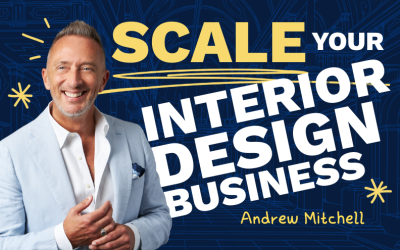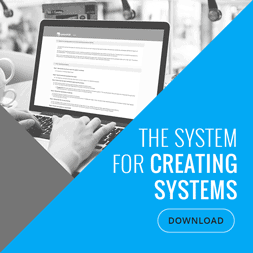When was the last time you (as a business owner) took a guilt-free holiday?
You know, one where you don’t have to worry about what’s going on with it while you’re gone. A holiday where you can feel confident that the business will still be running smoothly when you get back.
Sadly, most business owners start their business looking for freedom but they end up with the exact opposite – an owner dependent business that chains them to their desk.
So that’s the secret? How do you achieve Complete Business Reliability?
We’ve created a video that’ll help—so you can finally stop worrying and start relaxing.
In this video, David Jenyns talks about:
- Where are you on your journey to Complete Business Reliability?
- What are the key milestones you must cross to achieve your goal?
- Specific tips and actions you must take to start systemising your business
Timestamps:
0:13 – Step 1: Get tasks done without you.
0:38 – Step 2: Get the business to make money without you.
1:02 – Step 3: Have a guilt-free holiday.
1:52 – Step 4: “This is how we do things here.”
2:16 – Step 5: Complete business reliability.
4:06 – Identify your systems champion.
4:17 – Complete the Critical Client Flow.
4:23 – Complete the Multiple Viable Systems.
4:27 – Build systems into the DNA of the business.
5:34 – The action items you need to do at each stage.
5:56 – Once you achieve complete business reliability, it’s an ongoing thing
Formatted Transcription:
Here are the stages that you’re going to go through, and some of the wins that you’ll have as you progress up the mountain to complete business reliability. That’s where we’re looking to get to.
The first step at the base of the mountain is where you want to have the ability to get tasks done without you. So, you’re going to have to develop some skills around delegation, creating systems, and building up that muscle. Part of that is learning as you go through this. We’ll teach you some different tools and later on, I want to show you the way that I get systems done now just as an inspiration for you. That’s step number one.
As we progress up, in step number two, we want to get the business to make money without you. I’m assuming that—making money without you—that’s the whole point of your critical client flow. And it’s the proof that you can sell something without you being involved in it.
Once you get the critical client flow in place, once we train up team members on it, once you’ve got primary and secondary people identified, then we can kind of start to progress up because the business is making money without you, then you can start to think about having a guilt-free holiday.
What has to happen for a guilt free holiday is you need to have your CCS done and you need to get MVS done, and you need to have some key people in place. Does it mean that everything’s going to run perfectly and you’re going to come back and have zero problems? No. What it will mean though, is that things can get handled. And even if there are some little fires that bubble up, you can address that when you come back.
But I want you to set that goal for yourself, to be able to have that guilt-free holiday where you can take time out, go away with the family, and not be worrying about what’s going on at work and opening up your phone or email or things like that. I think every business owner deserves that, everybody deserves that. Team members are the same. They need to be able to have a holiday where they can step away and they’re not being dragged back to the business.
So we get there, when we get to CTF and MVS, the next step up, then we start to think about getting to, “this is how we do things here”. Now, for that to happen, we need to make sure that we start to build systems into the DNA of the business, where we’ve got recruitment, onboarding, policies, and position descriptions that identify the systems that are relevant to that particular role. Then, once we reach that, we start to really build that culture.
This is how we do things here with the ultimate goal of getting to the top of the mountain, which is complete business reliability. Now that’s where you’re a true business owner, where the business works without you, where you’ll have dashboards so you can keep an eye on what’s going on in the business and monitor it, but you’re not required.
You can work in the business by choice and you work on the things that you’re strong at and the things that you enjoy because that’s why you started this business. But you have the ability to kind of step in and out and the machine works without you. The business at this point really reaches optimization mode.
And we’ll talk about this idea of getting your business to the point where it operates under management and is a sellable asset (whether or not you sell). And the magic words that the potential buyer wants to hear is that the business is under management. What does that mean? That means it’s under management, not by the business owner. And that’s really where we want to get to the next step.
I’ve got some action items for you. What you need to go through to make this happen looks a little bit like this.
- Learning. How are you doing? I’m attending workshops like this, reading the SYSTEMology book and getting a general understanding of the SYSTEMology process. You can start off with the general and then over time as we loop in your systems champion, you might go into specifics that address certain parts of the seven stages of SYSTEMology. Maybe you need some help on your critical client flow when you have a look at the simple systems blueprint. Or maybe you join one of the group programs or go through the online program or you work with one of our SYSTEMologists. If you want to go that little bit further, you have to learn enough so that you can lead this initiative. Michael Gordon said don’t let the business owners off the hook, they need to lead the initiative. So you have to know enough to at least be able to have meaningful discussions with your systems champion and know what they’re doing and the leadership team and talk to the department heads.
- Identify the systems champion. We will talk about position descriptions, job ads, and I’ll give you all of those pieces of the puzzle today, but you have to identify that person.
- Oversee and work with the systems champion to complete the critical client flow.
- Oversee the completion of the MVS.
- Start to build these systems into the business DNA where we put it into our recruitment system. We’ll have a look at how you can onboard certain team members and have systems as a discussion. That final session that we do as part of the business systems accelerator, which is for your team, becomes part of your onboarding and you have it as a discussion that ‘hey, systems are important here’.
- Start to manage via systems. I’ll give you the framework that we’ll cover around how to manage and get people online. If you reach some resistance, we’ll talk about for your systems champion towards the end. This is the order in which you do it, and you don’t want to jump too far ahead. You always think about the next step as you work your way up the mountain.
- Optimize those systems and then get the processes in place for dashboards and the mechanisms to be able to listen to your business or see when there’s a problem and then try and go to work on the system and solve it at the system level.
The goal here is to achieve complete business reliability. The key here is that even though you may not sell, we just build it as though we are going to sell.
Once you achieve complete business reliability, it’s an ongoing thing. You don’t go ‘I’ve systemized, I can step away, I’m now done’. Once you reach that level, then it’s the pursuit of excellence. It’s about becoming an industry leader. It’s about continually innovating and improving because if you don’t continue to improve just over time, you drift down. There’s a natural drift. You’re either growing or you’re dying. So you need to make sure that you’re continually growing at that level.









